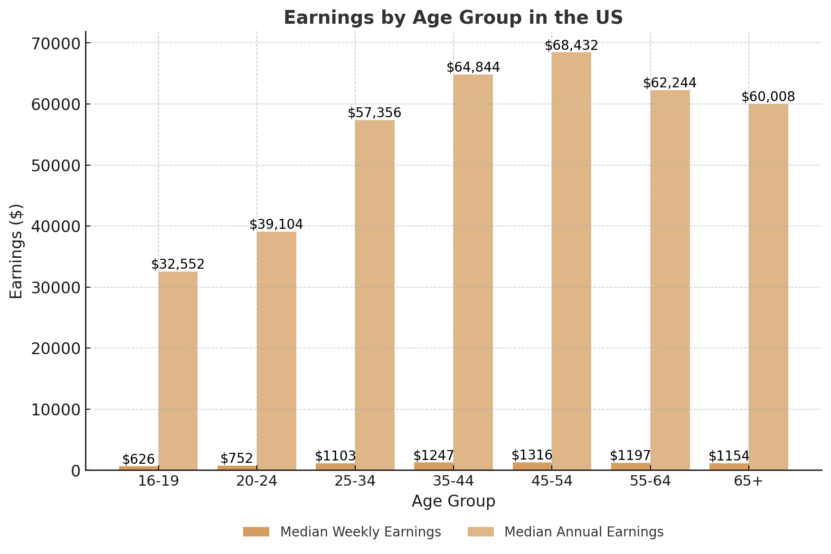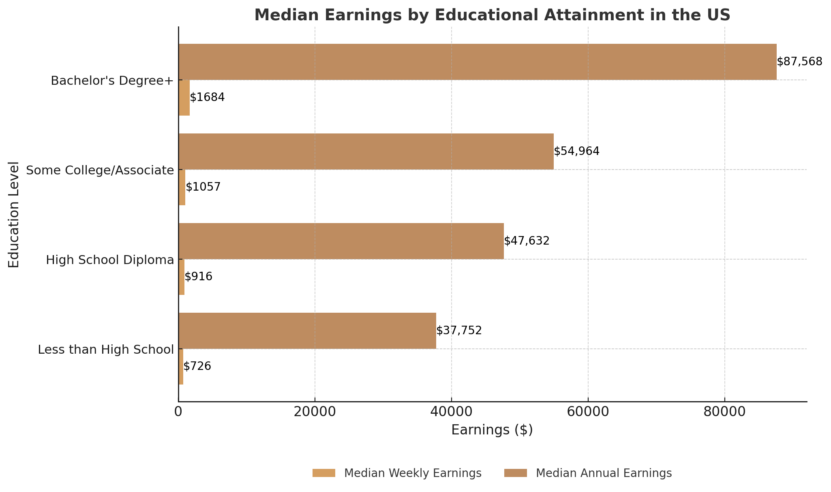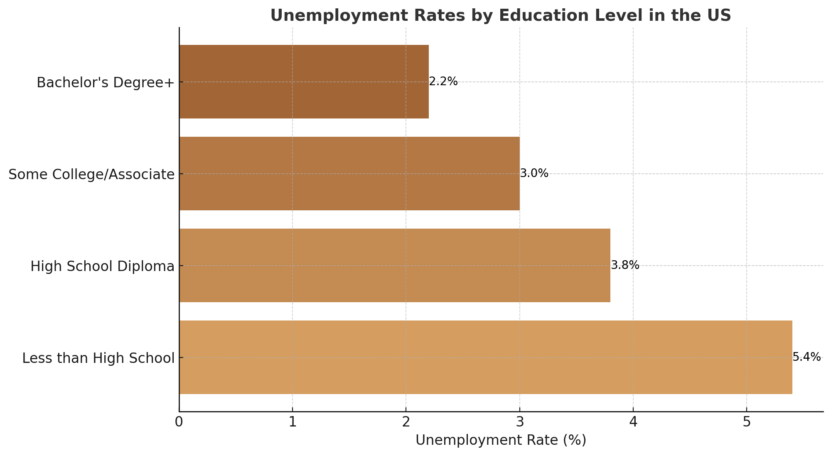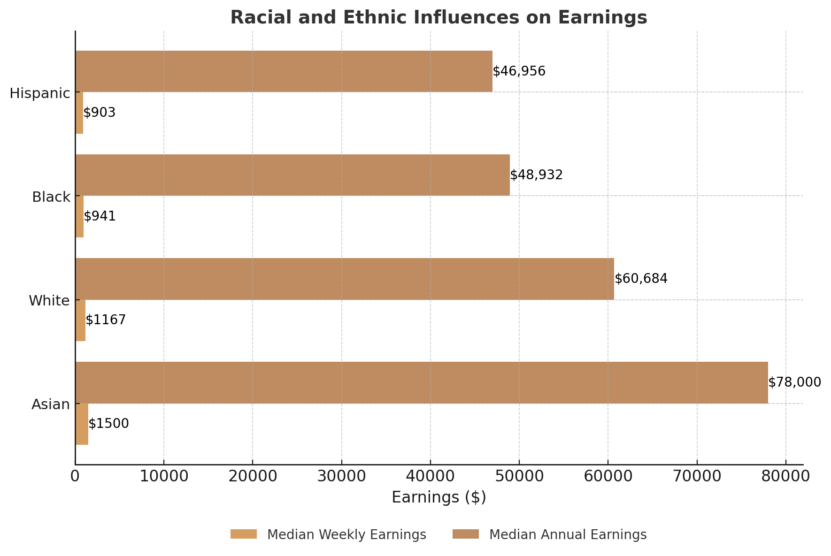
Share Post:
Earnings in the U.S. are shaped by multiple factors, with age, education, gender, and race playing key roles in income disparities.
As of 2025, the median weekly earnings for full-time workers stand at $1,192, translating to an annual income of approximately $61,984 according to recent data.
Higher education generally leads to increased earnings, yet gender and racial wage gaps persist across all educational levels.
Income peaks for most workers between ages 45-54 before slightly declining as individuals near retirement.
Examining these factors helps shed light on wage inequality and the broader economic landscape.
Table of Contents
ToggleEarnings by Age Group
Age often correlates with experience, which can impact earnings.
Here’s a breakdown of median weekly and annual earnings by age group:

The peak in the 45-54 age group can be attributed to a combination of factors, including accumulated experience, advanced skills, and often occupying higher-level positions within organizations.
After this peak, a slight decline in earnings is observed in the 55-64 and 65+ age groups, which may result from factors such as reduced working hours, transitioning to less demanding roles, or partial retirement.
This observed pattern is consistent with findings from various studies on income distribution by age.
For instance, data from the U.S. Bureau of Labor Statistics highlights that median earnings generally increase with age, starting from $31,928 for the 16-19 age group and peaking at $65,247 for the 45-54 age group.
The Education Factor: How Degrees Impact Earnings
Education plays a pivotal role in determining earnings. Let’s delve into how different education levels stack up:
Median Earnings by Educational Attainment

This pattern aligns with data from the U.S. Bureau of Labor Statistics, which shows that higher educational attainment is associated with higher earnings and lower unemployment rates.
Forbes notes that for instance, individuals with a bachelor’s degree have median weekly earnings of $1,334, while those with only a high school diploma earn $809 per week.
Moreover, the National Center for Education Statistics reports that, in 2022, 25- to 34-year-olds with a master’s or higher degree had median earnings 20% higher than those with a bachelor’s degree.
Unemployment Rates by Education Level
Here’s a look at unemployment rates by education level:

According to BLS data, as of February 2025, the unemployment rates for individuals aged 25 and older are as follows:
These statistics align with the trend that higher educational levels correspond to lower unemployment rates.
Several factors contribute to this correlation between education and employment stability:
- Skill Acquisition: Higher education equips individuals with specialized skills and knowledge, making them more competitive in the job market.
- Job Market Demand: Many industries require advanced degrees for entry-level positions, increasing demand for highly educated workers.
- Adaptability: Educated individuals often possess critical thinking and problem-solving skills, allowing them to adapt to changing job market conditions.
Gender Disparities in Earnings
Gender continues to influence earnings across various education levels.
Here’s a snapshot of median weekly earnings by gender and education:

The gender wage gap refers to the average difference in earnings between men and women.
Despite advancements in women’s educational and professional achievements, this gap persists due to various factors:
- Men and women often work in different industries and roles, with male-dominated fields typically offering higher pay according to American Progress.
- Career interruptions, often related to caregiving responsibilities, can affect women’s work experience and, consequently, their earnings.
- Unconscious biases and discriminatory practices can lead to unequal pay for equal work.
Impact of Education on the Wage Gap
While higher education generally leads to increased earnings, it doesn’t eliminate the gender wage gap.
The gap often widens at higher educational levels:
- High School Graduates: Women earn approximately 77% of what their male counterparts make according to Axios.
- Bachelor’s Degree Holders: Women’s earnings are about 77% of men’s earnings.
- Advanced Degree Holders: Women earn roughly 75% of what men with similar qualifications earn.
This trend suggests that while education boosts income for both genders, it doesn’t proportionally benefit women compared to men.
Racial and Ethnic Influences on Earnings
Race and ethnicity also play roles in earnings disparities.
Here’s how median weekly earnings vary:

According to the Wall Street Journal report, inflation-adjusted median household income increased by 4% to $80,610, returning to near pre-pandemic levels.
However, income gains were not evenly distributed across all racial and ethnic groups.
White non-Hispanic and Asian households saw significant income increases, while changes for Hispanic and Black households were negligible.
The Intersection of Age, Education, and Earnings
Combining age and education provides a more nuanced understanding of earnings. For instance:
- Young Adults (25-34): Those with a bachelor’s degree earn more than peers with only a high school diploma according to COE.
- Mid-Career Professionals (35-54): Advanced degrees often lead to higher earnings, reflecting accumulated experience and education.
- Older Workers (55+): Earnings may plateau or decline, but higher education levels continue to offer an advantage.
The Bigger Picture
Earnings are shaped by multiple factors, with age and education playing significant roles.
However, looking solely at these elements would provide an incomplete picture. Industry, occupation, and systemic disparities related to gender and race further complicate income distribution across different demographics.
Higher education generally correlates with increased earnings and lower unemployment rates, making it a valuable investment for many.
Yet, not all degrees hold the same weight in the job market.
A bachelor’s degree in engineering or finance often leads to higher salaries than one in the humanities or social sciences.
Similarly, work experience and industry demand significantly impact earning potential. For example, skilled trade workers in construction or manufacturing may out-earn college graduates in lower-paying fields.
The industry in which an individual works plays a crucial role in determining income. High-demand sectors like technology, healthcare, and finance offer significantly higher salaries compared to roles in retail, hospitality, or service-based industries.
Related Posts:
- What Does 'Level of Education' Mean? An In-Depth Look
- How Data Literacy Can Transform Patient Education
- Discrete and Continuous Data - Everything You Need to Know
- What Is the Average IQ of a 12-Year-Old?
- What Are the Standard Grade Levels by Age in the US?
- The High Cost of Education - 25 Most Expensive US.…












